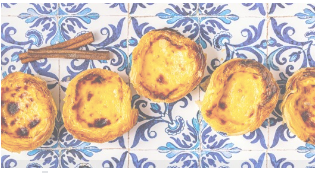Essential Dishes to Try in Portugal
- Clementine Moreno
- Sep 11, 2023
- 3 min read
There are so many Portuguese dishes, but which ones are actually worth a try?

Figure 1 - Portuguese custard tarts (Tatiana Bralnina, Shutterstock)
Portugal is known for its varied cuisine, but it is most popular for its delicious pastries, with the famous custard tart that has attracted so many tourists to the beautiful capital city of Lisbon. Portuguese dishes include meats, seafood, vegetables and legumes and desserts. The roots of Portuguese food lie in both native peasant cookery and the ingredients obtained through trade routes established many centuries ago. Bread, rice, spices, pastries, sausages, and seafood — especially cod — remain the staples of many Portuguese meals. For this article, I thought it would be very exciting to explore the Portuguese cuisine and recommend certain dishes, especially because there are so many options that fit different taste buds.
Pastel de Nata (custard tart)
Portuguese egg tarts, a little and indulgent delicacy that some could argue is the most delicious of sweets you'll ever get for €1.15, are the nation's most well-known dessert. Even if you know almost nothing about Portuguese food, you're probably familiar with it. You can find them as pastel de Belém at Antiga Confeitaria de Belém, where it is supposed to have started in the Lisbon suburbs in 1837 and is popularly known as pastel de nata globally.
The UNESCO-listed Jerónimos Monastery in the area passed down the original recipe, which is now secret. However, the key lies in the tactile contrast between the flaky pastry crust and the creamy egg custard interior. According to the recipe, the top is coated with powdered sugar and/or cinnamon. The tarts are baked until the tops are burnt at a high temperature.
Where can I get them:
Manteigaria – Fábrica de Pasteis de Nata
Antiga confeitaria de Belém
In any Portuguese pastry shop
Porco preto (Iberian black pork)
Black pig , or porco preto, are native to Iberia and are descended from the Phoenicians, who introduced pigs to the peninsula and crossed them with wild boars to create the distinct breed that is now found in Portugal and Spain. Nothing compares to the absolutely amazing, slow-cooked version at Évora's Taberna Tipica Quarta Feira in the interior region of Alentejo—the heart of pork country. The Portuguese enjoy their meat in a variety of ways, ranging from charcuterie (presunto ibérico) to grilled secretos (a fatter, pork belly-like cut) to enchidos (pork sausages). If you're familiar with the Mexican delicacy carnitas, think of this luscious, acorn-fed pig that is cooked for hours in its own juices and offered all-you-can-eat at this straightforward.
Where to try it: Taberna Típica Quarta Feira, Évora
Arroz de pato (duck rice)
Aside from pork, duck is one of Portugal's best meat dishes. Duck rice is a delicious combination of tender duck that has been boiled, shredded, and added to a bed of Carolino rice (a dish made with duck stock, onions, and garlic). It is then slightly baked before being topped with spicy chouriço sausage and served with orange slices.
It comes from Alentejo but, like many of Portugal's heartier recipes, spread fast throughout the nation. You may eat this delicacy inside Teresa Ruo's 17th-century farmhouse in the little village of Louredo, which is about 25 miles east of Porto, where she is the chef of the acclaimed Cozinha da Terra. It's similar to dining at your grandmother's home.
Where to try it: Cozinha da Terra, Louredo
Sardinhas assadas (grilled sardines)
The Portuguese summer may bring sunshine and clear sky, but the forecast is never guaranteed to be favorable. However, throughout the summer holiday season, historic neighborhoods around Lisbon (and abroad) are filled with the delicious smell of grilling sardines.
A snack of freshly grilled sardines is widely available from June to October, when they are at their plumpest and tastiest (outside of that period, they are likely to have been frozen), starting with the celebrations of one of Portugal's most cherished saints, Santo António.
As is customary with the tastiest cuisines, preparation is straightforward: Sardines that have been lightly salted and grilled over hot coals are typically eaten with a piece of broa (corn bread) or are offered with customary sides in restaurants.
Where to try it: O Pitéu, Lisbon






Comments